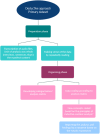Facilitators and challenges of implementing a digital patient education programme for rheumatoid arthritis into clinical practice
- PMID: 39304859
- PMCID: PMC11414131
- DOI: 10.1186/s12913-024-11597-6
Facilitators and challenges of implementing a digital patient education programme for rheumatoid arthritis into clinical practice
Abstract
Background: The integration of telehealth interventions into clinical practice is frequently delayed, hindering the full adoption. Previously, we developed a digital patient education (PE) programme for self-management in rheumatoid arthritis (RA). While the programme design considered crucial factors to ensure the likelihood of success in clinical practice, there is a need for a systematic evaluation of implementation perspectives. The purpose of this study was to explore perspectives crucial to implementation of a digital PE programme in clinical practice.
Methods: The non-adoption, abandonment, scale-up, spread and sustainability (NASSS) framework was used to evaluate the successes and challenges of implementing the digital PE programme. We included a data set consisting of qualitative focus group discussions involving study nurses, rheumatologists, and leaders from rheumatology departments. Data analysis was guided by a deductive content analysis approach. Further we included data from earlier studies pertaining to the programme's implementation, comprising the programme development process, a randomized controlled trial evaluating the programme's effectiveness, and a qualitative study exploring patients' perspectives of the programme.
Results: Facilitators and challenges of importance to implementation of digital PE were identified. While a wide range of patients could benefit from using digital PE, future implementation should aim for an even broader group than those studied. Both patients and healthcare providers embraced the technology, and the fact that it did not require specific technical skills enhances its potential for success. However, offering digital PE should be based on individual assessments, and expanding its use will require organizational adjustments. An adaptable structure is needed to accommodate unforeseen care needs that may arise following the use of digital PE at home. There was indication of some reluctance among healthcare providers toward the programme shown by concerns about changing roles, which could impact the adoption of the program.
Conclusions: The design and ease of use of the technology, the program's effectiveness, its availability, and the potential to release healthcare resources may encourage the implementation of digital patient education. Challenges associated with implementing this mode of care pertains to the condition and the patient population, user adoption of the technology, and the organization of patient education.
Trial registration: The study is registered by the Central Denmark Region Scientific Committee (no. 1-16-02-52-19).
Keywords: Digital patient education; Implementation; NASSS framework; Self-management support; Telehealth.
© 2024. The Author(s).
Conflict of interest statement
The authors declare no competing interests.
Figures


References
-
- de Thurah A, Bosch P, Marques A, Meissner Y, Mukhtyar CB, Knitza J, et al. 2022 EULAR points to consider for remote care in rheumatic and musculoskeletal diseases. Ann Rheum Dis. 2022;8(1):e002290. - PubMed
-
- Najm A, Nikiphorou E, Kostine M, Richez C, Pauling JD, Finckh A, et al. EULAR points to consider for the development, evaluation and implementation of mobile health applications aiding self-management in people living with rheumatic and musculoskeletal diseases. RMD Open. 2019;5(2):e001014. - PMC - PubMed
-
- Solomon DH, Rudin RS. Digital health technologies: opportunities and challenges in rheumatology. Nat Rev Rheumatol. 2020;16(9):525–35. - PubMed
-
- de Thurah A, Bremander A, Primdahl J. High-quality RMD rehabilitation and telehealth: evidence and clinical practice. Best Pract Res Clin Rheumatol. 2020;34(2):101513. - PubMed
MeSH terms
Grants and funding
LinkOut - more resources
Full Text Sources
Medical

